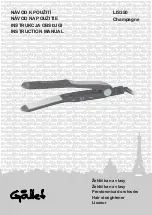
16
How to Use the Sauna?
Taking a Sauna bath is a simple affair without many rules. It’s a matter of getting inside the Sauna
and enjoying the sensation. There are just a few established procedures that are wise to follow:
Leave your clothes in the dressing room. Make sure you have a clean set of clothes to change into
after taking a sauna.
Always take a shower before entering the Sauna.
Always use a towel to sit on or lie on inside the Sauna.
While in a sauna heater operation mode, the humidity of the Sauna Room can be increased by
throwing water on the stones. One to three ladles of water at a time are enough for you to enjoy the
Sauna.
The recommended temperature of a Sauna is 65 to 80 degrees Celsius.
In steamer mode, the recommended temperature of a Sauna is 40 to 50 degrees Celsius.
When the heat begins to get uncomfortable, leave the Sauna and cool off by taking another shower,
or taking a quick dip in the pool or simply sitting outside the Sauna.
You can repeat the hot and cold cycle as often as you want. Two rounds are enough for average
people.
End your sauna with a thorough wash.
Thoroughly cool off before putting on clean clothes.
Top your sauna with a refreshing drink or by simply taking a rest.
8.1.
•
•
•
•
•
•
•
•
•
•
•
Temperature of the Sauna Room?
The temperature and humidity inside the Sauna Room can be monitored with a sauna thermometer
and hygrometer, respectively.
The effect of temperature and moisture on an individual varies, thus it is difficult to recommend the
ideal bathing temperature. Therefore, a bather can enjoy the sauna according to his preferred
temperature.
Ventilation inside the Sauna is important to keep the air fresh and easy to breathe in.
8.2.
•
•
•
Drying the Sauna Room After Use
Always dry the Sauna after every use.
Open the ventilation louver on the ceiling and turn on the heater for a quick drying of the Sauna.
Make sure to turn off the heater once the Sauna Room is dried.
8.3.
•
•
•
Ventilation of the Sauna Room
Sufficient ventilation is extremely important to maintain fresh air inside the Sauna Room.
In an hour, the air inside the Sauna Room should change completely five times.
If possible, fresh air should flow directly from outside.
The stale Sauna Room air should escape through a ventilation louver in the ceiling located as far as
possible from where the heater is placed.
Figure 13 shows a typical Sauna Room ventilation example.
8.4.
•
•
•
•
•
8. The Sauna Room
Fig. 13 Sauna Room Ventilation
17
Hygiene Inside the Sauna Room
There are basic hygiene practices that should be observed when taking a Sauna:
Always use a towel to sit or lie on inside the Sauna to prevent the sweat from dripping directly on
the bench.
Used towels should be washed after bathing.
Once the Sauna Room is dried, sweep or vacuum the floor and wipe off dirt with a damp cloth.
The Sauna Room should be subjected to a general cleaning every six months. This would include
scrubbing the walls, benches and floor with a brush and a suitable cleaning agent.
Wipe off dust and dirt from the Combi Heater with a damp cloth.
8.5.
•
•
•
•
•
Parts and Insulation of the Sauna Room
To minimize power consumption of the heater, massive wall surfaces such as bricks or glass blocks
should be properly insulated.
A well-insulated Sauna Room should have 12 to 15mm thick walls and ceiling panels.
To protect the Sauna Room from ingress of moisture, aluminum paper should be fitted within the
panels with its glossy surface facing the inside of the Sauna Room.
There should be a 10mm gap between the moisture protection and panel boards to serve as
ventilation gap.
An insulating wool (50 to 100mm) should be used within the panels.
NOTE:
Heat protection material such as a mineral board, which is directly attached to the wall or ceiling of
the Sauna Room can raise the temperature of the wall and ceiling materials to a dangerous level.
Consult local building safety authorities to determine which part of the fireproof wall may be
insulated.
To avoid damaging the flooring (where the heater is placed) with stone crumbles (small hot pieces
of stones), use dark joint grouts and stone-based floor materials.Do not use a light grout or a plastic
floor covering.
Due to wall surface processing with protective panel agents, wall blackening can occur and might
occur faster than expected because of the sunlight and heat from the heater.
The maximum allowable temperature for wall and ceiling surfaces in the Sauna is 140 degrees
Centigrade.
8.6.
•
•
•
•
•
•
•
•
•
Combi Heater Output
The output of the Combi Heater is determined by the volume and elements of the Sauna Room such as
glass windows and concrete or tile surfaces.
Each square meter of these elements increases the volume of the heated Sauna Room by 1.2 cubic meter.
It is important to have sufficient insulation within the wall and ceiling panels to prevent wastage of heater
power.
Log Sauna Room volume shall be multiplied by 1.5 since walls made of logs heat up slowly.
8.7.
•
•
•
•




























